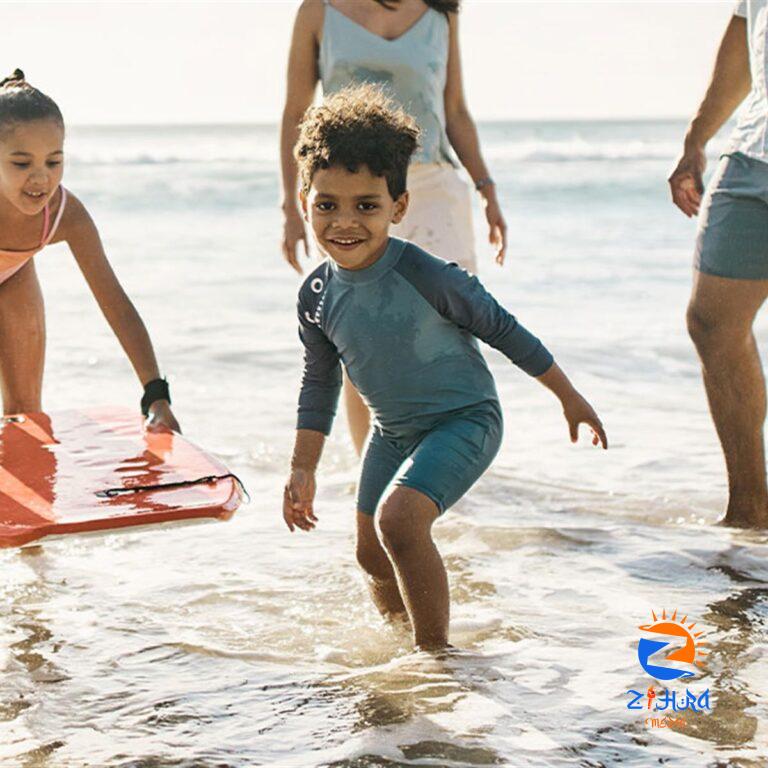
[ad_1]
By: Lois Lee, MD, MPH, FAAP
When the weather’s nice, many families love spending time near the water. Whether your favorite spot is at the edge of an ocean, river or lake, here are ways to make sure that health hazards don’t spoil your good time.
Choose a safe spot
Look for beaches where lifeguards are on duty.
Keep an eye out for postings about
water quality,
rip currents and
shorebreak, which can make swimming and water play unsafe. (Keep in mind that if high bacteria counts are present in the water, the sand will be unsafe as well.)
Scan the sand.
Before spreading out your beach blanket, look for debris that may have washed up, including sharp sticks, bottles or even jellyfish. (Here are
first-aid tips that can help if your child does encounter a jellyfish.)
Watch for sand holes.
Making sandcastles and sculptures can be a blast! But the hole your child digs in the sand should never be deeper than their own knee. Children can fall in and get trapped or buried in the sand, which can suffocate them.
Have kids dig where you can watch them—and don’t allow digging in sand dunes, where loose sand can collapse around them. For everyone’s safety, always fill the sand holes your crew digs before you leave. Sometimes, holes that children can fall into are not always obvious or clearly visible in the sand.
Check the water temperature.
Generally, water between 82° F and 86° F (28° C to 30 C°) will be safe and comfortable for young swimmers. (If the temperature isn’t posted, ask your lifeguard.)
Keep an eye on the sky for changing weather.
Lightning strikes pose real dangers, so when you hear that familiar rumble, head indoors! The safest place during a thunderstorm is a substantial building or a hard-topped vehicle. Wait at least 30 minutes after the storm passes before heading back to the beach.
Play safely at the shore
Teach kids to respect the water.
At the seaside or lake, they should always face the water so they can see new waves coming in. Teach kids to wade in feet-first so they can check the water’s temperature and depth. Make sure they never dive or jump from high points such as a bridge, boat or dock, where shallow depths or underwater debris can cause serious head and spine injuries.
Appoint a water watcher.
This should be a grownup with good swimming skills who keeps a consistent eye on the water and shoreline. When it’s your turn, put away your smartphone, book or any other distractions, and skip the alcohol to help you stay alert. If you’re in a big group, choose more than one water watcher to take turns or rotate duties.
Know when to wear
life jackets.
Small children and those without strong swimming skills should wear a life jacket in or near the water, the Red Cross says. Families should also don certified life jackets whenever they’re boating, paddling, waterskiing or skimming along on jet skis.
Require adult permission before kids go in any kind of water.
Make sure they always check in with a parent or trusted adult before entering the water.
Use the buddy system whenever kids are in the water.
For young kids, this means having an adult beside them, within arm’s reach, whenever they’re in the water, keeping one hand on them while they float, paddle or play. This is called touch supervision.
As kids gain water safety skills (and show they can be trusted to stick together), they can swim and splash in groups. The forever-and-always rule is that no one goes in the water alone.
Prevent sunburn & heat illness
Prep your skin for the sun.
Sunburns can turn a fun outing into a painful experience. Here are ways to avoid childhood burns that boost
skin cancer risks later in life.
-
Choose a broad-spectrum sunscreen labeled with an SPF of at least 15 or 30. Mineral sunscreens can be especially effective. -
Put sunscreen on at least 30 minutes before hitting the beach, using the equivalent of a full shot glass to protect your child. (Don’t forget the tops of feet, hands and ears.) -
Reapply every 2 hours or right after your child leaves the water, since no sunscreen is 100% waterproof or sweatproof. -
Sunscreen often causes skin reactions in
babies under 6 months, so it’s best to protect little ones with a wide-brimmed hat and lightweight clothing that covers their arms and legs. Stake out a shady spot where they can play or nap safely. -
Rash guards, long-sleeved tops and other cover-up beachwear offer extra protection for toddlers and older kids, especially between 10 a.m. and 4 p.m. when UV rays are strongest. (You may also want to shield feet with water shoes, flip flops or sneakers on very
hot days, since the sand’s surface can climb as high as 100° F (38° C)!
Consider finding shade during peak sun hours.
If you use a
beach umbrella , be sure it is anchored securely in the sand. Umbrellas that fly away in the wind have caused serious injuries. (Also, remember that beach umbrellas do not offer enough UV protection, so sunscreen is still needed.)
Keep everyone cool and hydrated.
Kids can easily overheat when they’re having fun. Avoid
heat illness by having plenty of water on hand, offering them frequent sips and calling for occasional shade breaks. (Here’s
how to tell if your child is getting dangerously hot.)
Remember
Ask your pediatrician if you have any questions or concerns about safety during an upcoming outing or vacation in the sun and water.
More information
About Dr. Lee
|
The information contained on this Web site should not be used as a substitute for the medical care and advice of your pediatrician. There may be variations in treatment that your pediatrician may recommend based on individual facts and circumstances.
[ad_2]
 Lois Lee, MD, MPH, FAAP, Chair of the American Academy of Pediatrics Council on Injury, Violence and Poison Prevention, is a pediatric emergency medicine physician at Boston Children’s Hospital and Associate Professor of Pediatrics and Emergency Medicine at Harvard Medical School. Dr. Lee has published seminal research on pediatric emergency medicine, health disparities and injury prevention, including related to firearms. Dr. Lee’s expertise was recognized with her election to the National Academy of Medicine in 2023.
Lois Lee, MD, MPH, FAAP, Chair of the American Academy of Pediatrics Council on Injury, Violence and Poison Prevention, is a pediatric emergency medicine physician at Boston Children’s Hospital and Associate Professor of Pediatrics and Emergency Medicine at Harvard Medical School. Dr. Lee has published seminal research on pediatric emergency medicine, health disparities and injury prevention, including related to firearms. Dr. Lee’s expertise was recognized with her election to the National Academy of Medicine in 2023.